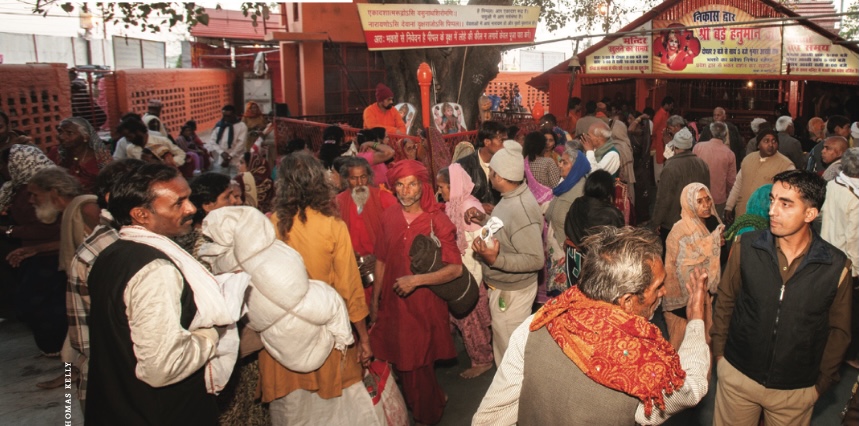Worshiping the great bhaktar: Devotees throng the courtyard outside the temple; passing security personnel receive blessings from the sacred flame after the worship
• • • • • • • • • • • • • • • • • • • •
HANUMAN: SANGAM’S ANCIENT GUARDIAN
THE 18TH INCARNATION OF SHRI HARI, MIGHTY HANUMANJI, is undoubtedly one of the most popular characters in the Ramayana. Here at Prayag, He is worshiped in a unique resting position in a temple on the banks of Sangam.
Swami Ananda Giri is a disciple of Swami Narendra Giri, the 16th head of the Baghambari Peeth which has administrated the temple for the last 700 years—even during the Mughal period. Swami Ananda explains, “Hanuman is a very important Deity for us. He is treated as kotwal, the chief of security, of this Tirthraj Prayag. Anyone who has a bath at Sangam must have darshan of Lord Hanuman. Then only is one’s pilgrimage complete. The main attraction of this particular temple is that here He is in a lying-down posture, taking rest. It is believed that in Treta Yuga, when Lord Rama was going back to Ayodhya after defeating Ravana, Hanuman Ji stopped at this place to rest and recover from the injuries He had suffered in the war in Sri Lanka. Hanumanji found this place soothing, as all the three rivers flowed together here and the whole atmosphere was serene. In fact, He laid down, determined to leave his body at such a holy place. He expressed this intention to Sita and sought permission to leave the body in Her divine presence. Sita started weeping and said that if Hanuman ever left this world then there would be no one to do the selfless service. All the great bhaktas or devotees of this world have one aim, and that is to get liberated from the cycle of birth and death. Hanumanji was born not to get liberated but to grant liberation. He served those who served Lord Rama. Sita applied sindur (orange-red powder) to the body of Hanuman and declared that as long as the name of Lord Rama is in this world, Hanuman will be immortal and always known.”
Priests decorate the murti of Lord Hanuman
• • • • • • • • • • • • • • • • • • • •
